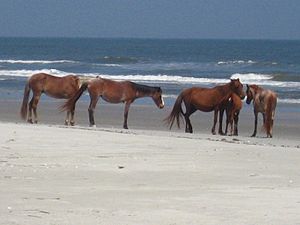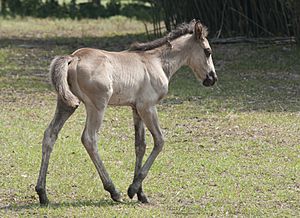Cumberland Island horse facts for kids

Cumberland Island horses on the beach
|
|
| Country of origin | United States |
|---|---|
| Horse (Equus ferus caballus) | |
The Cumberland Island horses are wild horses living on Cumberland Island in Georgia, USA. Many people believe these horses first arrived with Spanish explorers in the 1500s. However, it's more likely their ancestors came with English settlers in the 1700s. These horses are similar to other wild horse groups found on islands like Chincoteague and Assateague.
Today, about 150 to 200 horses live on the island. They have a shorter life than other horses. This is because of pests, diseases, and the tough island environment. Studies show that these horse groups often change members. Many male horses (called stallions) share leadership. Young horses also leave their birth groups early.
The National Park Service (NPS) has managed Cumberland Island since 1972. Researchers have studied the horses since the late 1980s. Some studies suggest that too many horses harm the island's environment. They recommend reducing the horse population. Other studies look at their genes. They say a large herd is needed to prevent inbreeding (when closely related animals have babies). The NPS does not currently have a plan to manage the horses.
Contents
History of Cumberland Island Horses
Horses are not originally from Cumberland Island. A popular story says Spanish explorers brought them in the 1500s. But it's thought these first horses probably didn't survive. The Spanish didn't visit often, and local Native Americans didn't use them much.
English Settlers and Wild Horses
In the 1700s, English settlers began living on Cumberland Island. The horses you see today likely came from these settlers. Many of these horses started to roam freely. They became feral, meaning they returned to a wild state.
During the 1800s, people tried to catch and use the horses. Robert Stafford, a plantation owner, let visitors buy and capture them. He called them "marsh tackies." Later, some horses were used as cavalry animals during the American Civil War. After the war, some horses were even caught for horse meat.
Improving the Herd
Around 1881, Thomas M. Carnegie bought land on the island. He brought in new horse breeds like Tennessee Walking Horses, Paso Finos, and Arabians. He wanted to make the wild horses better. He even made a little money by selling them. Over time, other island residents also added different breeds to the herds. This made the horse groups even more diverse. In 1921, many wild horses from Globe, Arizona were brought to the island.
National Park Service Management
The National Park Service (NPS) took over the island in 1972. They named it the Cumberland Island National Seashore. Since then, few new horses have been added. In the early 1990s, four Arabians were brought in. This was to help the existing horses have more varied genes.
Since 1981, the NPS has watched the horses closely. They track how the horses affect the environment. In 1991, a disease called eastern equine encephalitis killed about 40 horses. This was about 18% of the herd. The Cumberland Island horses are one of seven wild horse herds on US barrier islands.
Characteristics of the Horses
In 2009, a study estimated about 200 wild horses on Cumberland Island. In 2010, a count found 121 horses. Counts between 2000 and 2010 showed between 120 and 154 horses. Park managers believe about 50 horses are missed each year. So, the real number in 2010 was closer to 170 horses.
Life Expectancy and Health
Horses on Cumberland Island live about half as long as their ancestors. This is due to many parasites and diseases. They also have tummy problems from eating too much sand. This sand can cause blockages in their intestines.
Herd Behavior
A study from 2000 looked at how the horse groups behave. It found that the groups were not very stable. Female horses (mares) often switched which male horse (stallion) they stayed with. Young horses also left their groups quickly.
Researchers think this happens because the horse groups often share the same areas. Also, there are many male horses without mares. They also saw that two or more stallions would sometimes lead a group together. They would take turns breeding with the mares.
Baby horses (foals) born on Cumberland Island were less likely to survive. About 58-61% survived, compared to 80% in other wild herds. Foals born after June 1st had an even harder time. This was likely due to hotter weather, more insects, and less food. The number of horses in Cumberland Island groups is similar to other wild herds. However, horses on Assateague and Shackleford Banks tend to have larger groups.


